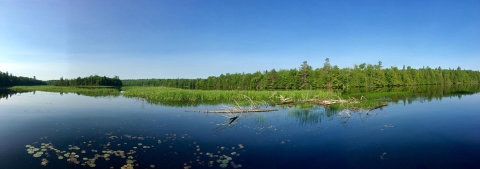Fish passage projects are underway across the country, transforming watersheds, improving climate resilience, and supporting local economies.
The Bipartisan Infrastructure Law Bipartisan Infrastructure Law
The Bipartisan Infrastructure Law (BIL) is a once-in-a-generation investment in the nation’s infrastructure and economic competitiveness. We were directly appropriated $455 million over five years in BIL funds for programs related to the President’s America the Beautiful initiative.
Learn more about Bipartisan Infrastructure Law was passed in 2021, providing nearly $2 billion for aquatic ecosystem restoration and fish passage fish passage
Fish passage is the ability of fish or other aquatic species to move freely throughout their life to find food, reproduce, and complete their natural migration cycles. Millions of barriers to fish passage across the country are fragmenting habitat and leading to species declines. The U.S. Fish and Wildlife Service's National Fish Passage Program is working to reconnect watersheds to benefit both wildlife and people.
Learn more about fish passage funding to multiple federal agencies. This investment is helping improve the health of watersheds and the ways that federal, state, and Tribal partners collaborate. As part of the program, the U.S. Fish and Wildlife Service was awarded $200 million over five years to distribute to local projects removing hundreds of barriers through the National Fish Passage Program.
In July 2022, the Service co-sponsored a National Fish Passage Bipartisan Infrastructure Law workshop to increase coordination and maximize the impact of this historic investment. This workshop helped establish new partnerships and bolster existing ones by identifying common goals, sharing agency expertise, and leveraging new funding opportunities. One of the important outcomes is an Interagency Fish Passage Task Force composed of thirteen federal agencies that continue to meet regularly.
The Task Force promotes the benefits of fish passage projects, provides technical advice and capacity across federal agencies, and better coordinates funding, creating transformational impact across the landscape. For example, the Service detailed an aquatic expert to FEMA’s National Dam Safety Program to help educate dam owners on the potential benefits of dam removal in preventing fish population declines and restoring the environment. The Task Force is already yielding important results that provide a model for continued success.
The Interagency Fish Passage Portal was created by the Task Force to share funding information and resources in a centralized location. This increases accessibility and reduces the burden on landowners, dam owners, cities, Tribes and more when looking for funding opportunities. The Portal also contains a dashboard of over 220 Bipartisan Infrastructure Law -funded fish passage projects, resources for training and guidance, and additional information about the Task Force.
A prime example of federal fish passage collaboration is the Federal Highway Administration’s (FHWA) Culvert Aquatic Organism Passage (AOP) Program. FHWA received $1 billion in Bipartisan Infrastructure Law funding for culvert projects that restore or improve passage for anadromous fish and is one of the first FHWA programs focused on aquatic habitat restoration. This landmark funding initiated a new era for FHWA and acted as a catalyst for interagency engagement. Through effective consultation with agencies at the Department of Interior and Department of Commerce, FHWA established the Culvert AOP Program, prioritized projects, and delivered funding. As a result, almost $196 million was awarded nationwide in 2023. These projects put FHWA’s years of experience collaborating with state, federal, and Tribal partners into practice through the lens of fish passage.
The Task Force is also identifying large-scale, transformational projects and working together to coordinate funding and technical assistance. The St. Croix River watershed in Maine is a prime example. The Woodland Dam has an outdated fishway, blocking historic spawning habitat for many at-risk species. Installing a new fishlift benefits migrating species like American eel and shad, as well as endangered Atlantic sturgeon downstream. The project will also restore access to historic habitat for millions of river herring. This large, complex project is possible due to coordination of USFWS, NOAA, and EPA, Canadian agencies, Passamaquoddy Tribe of Indian Township, Passamaquoddy Tribe of Pleasant Point, the State of Maine, and other conservation partners. Additional funding was provided by the America the Beautiful Challenge.
The first year of the Task Force has led to new partnerships, increased efficiency, and developed funding models that lead to better outcomes for people and nature. Effective communication and expertise sharing between Task Force agencies expands capacity and builds partnerships that will last for years to come.






